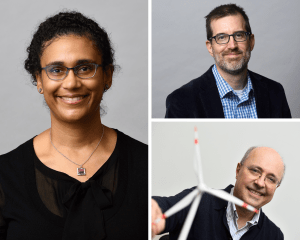Experts at the Ralph O’Connor Sustainable Energy Institute (ROSEI) are working with those at the Pacific Northwest National Laboratory (PNNL) through a Department of Energy-funded center aimed at bringing floating offshore wind turbines (FOWTs) to American waters. Currently, only four such wind farms exist in the world, located in the United Kingdom, Portugal, and Norway.
The Addressing Challenges in Energy: Floating Wind in a Changing Climate (ACE-FWICC) Center began its work in late September.

Dennice Gayme (left), Ben Schafer (top right) and Charles Meneveau (bottom right)
ROSEI researchers involved include Ben Schafer, the institute’s director and the Willard and Lillian Hackerman Professor of Civil and Systems Engineering, as well as Dennice F. Gayme, a Professor of Mechanical Engineering, and Charles Meneveau, the Louis M. Sardella Professor in Mechanical Engineering. The trio of Johns Hopkins researchers—as well as others associated with ROSEI—have longstanding individual connections with PNNL but this is the first time a collaboration has been set up directly between this national lab and multiple ROSEI experts. Leaders external to Hopkins include PNNL’s Larry Berg (principal investigator) and Julie Lundquist, a Professor of Atmospheric and Oceanic Sciences at University of Colorado, who is a frequent ROSEI collaborator.
“We’ve been talking to PNNL for quite some time, looking for ways to collaborate,” Schafer said. “The team Larry put together for this; you could tell it was going to be an exciting group. We were ecstatic when we found out they wanted us to be involved.”
Unlike traditional offshore wind turbines that are attached directly to the ocean floor, floating wind farms stand on buoyant structures that are anchored to the ocean bed by mooring lines. This key difference means that floating wind farm turbines can be placed in deep ocean waters, while standard offshore farms are restricted to shallower depths. However, floating farms bring with them added complication of the platform moving based on wind and tide conditions.
About 60 percent of US wind resources are in deep water, making floating windfarms an appealing energy source for the country, but they should be of particular use just off the west coast, where sea beds plunge rapidly from the coastline. This makes standard offshore wind farms infeasible.
“Working with a group based in the state of Washington is certainly appealing because they’re on the West Coast and are particularly motivated to have this work become successful,” Meneveau said. “The entire west coast is currently out of the picture for offshore wind energy, but that could change with this work.”
ACE-FWICC will focus primarily on developing a computational framework, or a “digital energy system”, linking the key components of floating offshore wind driving the cost of power in a changing climate. The digital energy system the group is creating will take a variety of components into account, including wind resources, wind and wave (metocean) conditions, wind plant design and control, and grid integration.
The aim is to model FOWTs, wind farms, and wind power distribution in a coherent and computationally efficient way, enabling the development of new strategies to reduce energy costs in current and future climates, the experts say.
“An array of turbines doesn’t act on their own, they interact with each other in a wind farm. They interact through the wakes and the wind field on the ocean,” Gayme said. “As the individual turbines will be moving with the waves, new behaviors can arise. For example, they could all synchronize or excite natural frequencies of the various components. Both power output and turbine loading will depend on the properties of the waves, the wind, and how they interact, which depends how the turbines are arranged.”
[perfectpullquote align=”left” bordertop=”false” cite=”” link=”” color=”” class=”” size=””]“When you yaw a turbine, it changes the wake. The question is how that modifies how the wind and waves affect the wake. How does that affect downstream turbines and the power output of the farm. We’re looking at these issues from a modeling and controls perspective.”[/perfectpullquote]
Each ROSEI researcher will work in different teams within the center. Though some researchers are simulating what wind energy will look like over the next century, Meneveau (who is working with Gayme on this) is examining how placing floating wind turbines in the middle of the ocean will affect those predictions.
“To get good answers you have to tell the metocean models that there are wind farms there,” Meneveau said. “That part is not well developed, so we will be developing simulations that take the wind farms into account.”
“An array of turbines doesn’t act on their own, they interact with each other in a wind farm. They interact through the wakes and the wind field on the ocean,” Gayme said. “As the individual turbines will be moving with the waves, new behaviors can arise. For example, they could all synchronize or excite natural frequencies of the various components. Both power output and turbine loading will depend on the properties of the waves, the wind, and how they interact, which depends how the turbines are arranged.”
As part of the controls group, Gayme will try to figure out how various environmental factors will affect the energy output potential for FOWTs.
“When you yaw a turbine, it changes the wake. The question is how that modifies how the wind and waves affect the wake. How does that affect downstream turbines and the power output of the farm,” Gayme said. “We’re looking at these issues from a modeling and controls perspective. It’s a topic that goes from structures to wake interactions.”
A structural engineer, Schafer is looking at the structural performance of the floating turbines’ blades and towers. The group is tasked with optimizing the models that predict turbine farm performance so that they can execute rapidly for real-time control and grid integration purposes.
“What’s interesting is how do we make a structure and reliably predict its performance in a floating condition with a major force way up in the air,” Schafer said. “Designing the Eiffel Tower is tough because it’s a tall structure, weighs a lot and the wind wants to knock it over. With this, we basically have the Eiffel Tower with a big force at the top of it because that’s where power is generated and it’s floating on the sea. It’s a fascinating issue to try to solve.”
Gayme notes that, from an economic and political perspective, the time is right to be doing this research. Onshore wind is among the cheapest forms of energy for utilities, so much so that it has made offshore wind the next frontier to be developed. It has helped drive global interest in producing even more affordable renewable energy, along with the understanding that renewable energy is a new sector that is opening many new jobs.
“A lot of political goodwill goes towards sectors that can open jobs, especially skilled ones with high pay,” Gayme said. “Every scenario where society wants to reduce greenhouse gas emissions requires a lot of wind and solar energy. The only way to do that is to harvest floating offshore wind so you can maximize the number of potential sites for wind farms. Those background pressures to meet these goals are playing into why this research is being done now.”
